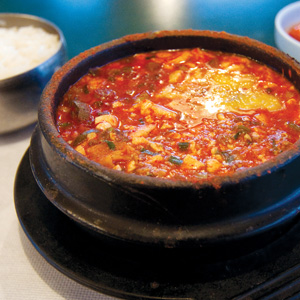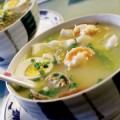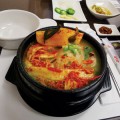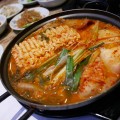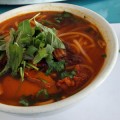As I was driving to work the other day, a thick layer of fog hung over the South Bay. The fog looked like it held a chance of rain. Fall was in the air. I wasn’t sure what I was going eat that day, but the gloomy weather helped me make up my mind: soontofu.
Cold and wet weather makes me think of soup, and one my favorite bowls of soup when the weather turns really chilly is soontofu, the Korean specialty made with soft tofu, a chile paste–infused broth and bits of meat, seafood and vegetables. Soontofu is really more of a stew because it’s so thick. If you think tofu is just for Birkenstock-wearing vegetarians, a bowl of soontofu (sometime spelled soondobu or soondooboo) will disabuse you of that notion.
Like Korean food in general, soontofu is hearty, often spicy and satisfying. As filling and nourishing as the soup is, there’s a lightness to soontofu that doesn’t weigh you down. The soup/stew arrives bubbling in a stone bowl heated in the fiery depths of the oven.
It’s usually available with a choice of spiciness. And when you say you want it spicy, that’s what you get. If you wondered how Koreans survive the bitter cold of a long Korean winter, smoldering bowls of soontofu are definitely part of the answer. But soontofu doesn’t have to spicy to be good. Spicy or not, the chile paste tints the soup a beautiful red/orange and gives the dish a great depth of flavor.
AS I WAS driving to work the other day, a thick layer of fog hung over the South Bay. The fog looked like it held a chance of rain. Fall was in the air. I wasn’t sure what I was going eat that day, but the gloomy weather helped me make up my mind: soontofu.
Cold and wet weather makes me think of soup, and one my favorite bowls of soup when the weather turns really chilly is soontofu, the Korean specialty made with soft tofu, a chile paste–infused broth and bits of meat, seafood and vegetables. Soontofu is really more of a stew because it’s so thick. If you think tofu is just for Birkenstock-wearing vegetarians, a bowl of soontofu (sometime spelled soondobu or soondooboo) will disabuse you of that notion.
Like Korean food in general, soontofu is hearty, often spicy and satisfying. As filling and nourishing as the soup is, there’s a lightness to soontofu that doesn’t weigh you down. The soup/stew arrives bubbling in a stone bowl heated in the fiery depths of the oven.
It’s usually available with a choice of spiciness. And when you say you want it spicy, that’s what you get. If you wondered how Koreans survive the bitter cold of a long Korean winter, smoldering bowls of soontofu are definitely part of the answer. But soontofu doesn’t have to spicy to be good. Spicy or not, the chile paste tints the soup a beautiful red/orange and gives the dish a great depth of flavor.
As the lunch hour drew near, I headed to Silicon Valley’s epicenter of Korean food, El Camino Real in Santa Clara. The stretch of El Camino Real just north and south of Lawrence Expressway is a gold mine of Korean food, one of the top spots in the Bay Area. The area is also great for south Indian food, but that’s another story.
My first stop on my soontofu sojourn was Choi’s. I wrote about the place when it was Blue Stones, and the soontofu was pretty good, but Choi’s is even better now. The place looks the same: bright fluorescent light, Formica tables and posters of busty Korean women selling Korean beer.
Most of the tables are full at lunch, when a mainly Korean crowd devours the daily specials. I wasn’t interested in a lunch special, but I was there for a special lunch—soontofu.
The soup typically comes with pieces of beef, pork, seafood or vegetables. Now that I think about it, I’ve never seen it with chicken. Strange. Anyway, I tried the kimchi and pork soontofu and the beef dumpling soontofu (both $8.99). I loved them both.
The kimchi was actually downplayed in the first one. What came through was the deep and smoky flavor of the chile paste and the hearty sweetness of the pork and onions. Soontofu with dumplings is a rendition I haven’t seen before. The slippery dumplings are tightly packed with minced beef, ginger, chives and garlic, and they hold up well in the sizzling, molten soup.
Choi’s puts out an impressive spread of banchan: eight plates of pickled, fermented and boldly seasoned condiments meant to accent the meal. Knowing that I was going to make another stop for lunch, I tried not to dig in too deeply. But everything is good, especially the jellolike turnip cake and pickled turnip. I like turnip.
With my belly full, I headed to Sui Tofu, one of my favorite El Camino Real Korean restaurants. I don’t usually double up on lunch, but I was behind schedule and needed to cover a lot of ground. I am, however, a professional and train for just such situations.
Sui is known for its rice porridge, but the soontofu is a standout, too. Sui Tofu makes its own tofu in-house, a rarity in my travels throughout Santa Clara’s Koreatown. Two versions of soontofu offer a lesson in tofu making.
Cho dang soontofu ($8.99) is described as “fresh bean tofu with special house sauce.” I ordered it, but my server warned me that it was rather bland. Unlike the typical preparations that combine crumbling soft tofu with a chile-paste broth, cho dang soontofu is made from what’s pressed out of fresh tofu: a watery, curdlike form of tofu. And bland it is—about as flavorful as tap water.
Dab in a few spoonfuls of the soy-sesame oil-–green onion sauce, and the dish comes to life. It’s still quite austere, but I can see the appeal. It felt nourishing and elemental, like a glass of fresh cow’s milk or a carrot just plucked from the garden.
By contrast the “mix tofu soup” ($7.99) is made from fresh tofu ground to the consistency of Cream of Wheat. This soup is still worlds apart from the soontofu I had down the street at Choi’s, but it has a nutty, rich quality to it that really grew on me.
I also ordered a plate of the restaurant’s excellent potstickers ($6.99), panfried vegetarian bundles filled with rice noodles, egg, onions, garlic and other goodies.
The next day, I had soontofu again, this time at Secret Garden. I had passed the restaurant at the back of a little minimall before but had never eaten there. Secret Garden feels a bit like a secret, even though it has been around since 1979. You can’t see inside because of the tinted windows, but the place has the qualities of a retreat. Intricate woodwork and, oddly, mirror panels adorn the ceilings, while the red carpet and cozy booths make the place seem far removed from El Camino Real outside. Secret Garden was packed at lunch as I grabbed one of the last tables.
Looking down the list of soontofu, the clam and pork ($9.95) caught my eye; it’s a combination I hadn’t seen before. The sizzling bowl didn’t have quite the depth of flavor I encountered at Choi’s, but the whole clams and bits of pork were good swimming in the bubbly chile-paste broth.
I couldn’t help but order the raw crab appetizer ($14.95) as well, with meaty blue-crab legs marinated in a thick chile-pepper paste. The dish is described as spicy, but I would give it about a 3. But the flavor gets a much higher score. The crab meat has a silken, rich quality, like tuna tartare. Matched with the chile paste, it’s delicious. And messy.
By the time I emerged from the little Korean food sanctuary, the sun was out, and it was another warm day in Silicon Valley. The rain would come soon enough. But I discovered soontofu tastes pretty good in warm weather, too. It’s all-season soup.
